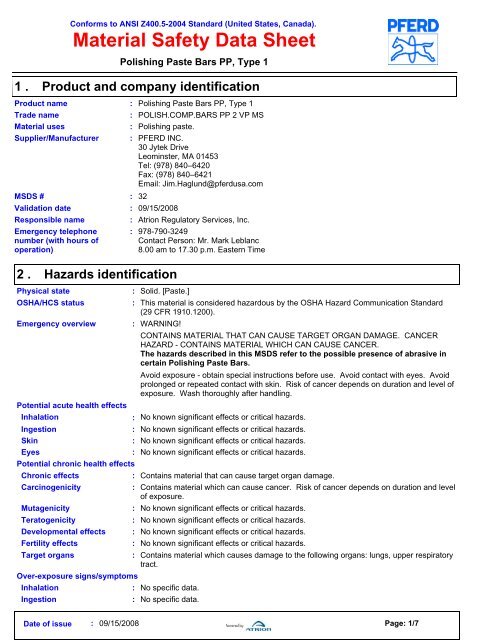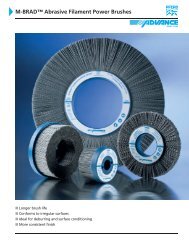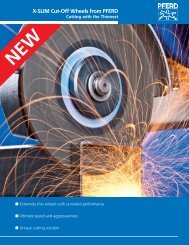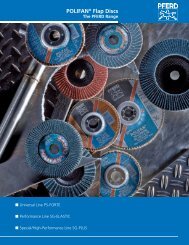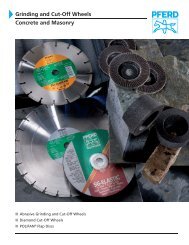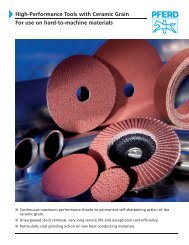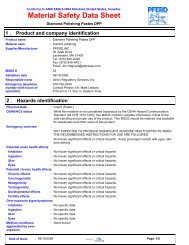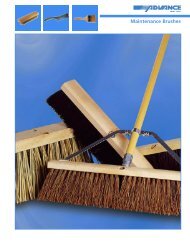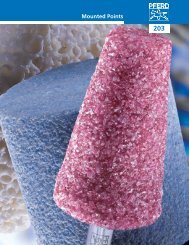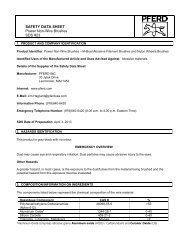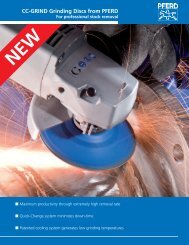Material Safety Data Sheet - Pferd
Material Safety Data Sheet - Pferd
Material Safety Data Sheet - Pferd
Create successful ePaper yourself
Turn your PDF publications into a flip-book with our unique Google optimized e-Paper software.
1 .<br />
Product name<br />
Trade name<br />
<strong>Material</strong> uses<br />
Supplier/Manufacturer<br />
MSDS #<br />
Validation date<br />
Responsible name<br />
Conforms to ANSI Z400.5-2004 Standard (United States, Canada).<br />
<strong>Material</strong> <strong>Safety</strong> <strong>Data</strong> <strong>Sheet</strong><br />
Polishing Paste Bars PP, Type 1<br />
Product and company identification<br />
Emergency telephone<br />
number (with hours of<br />
operation)<br />
2 .<br />
: Polishing Paste Bars PP, Type 1<br />
: POLISH.COMP.BARS PP 2 VP MS<br />
: Polishing paste.<br />
: PFERD INC.<br />
30 Jytek Drive<br />
Leominster, MA 01453<br />
Tel: (978) 840–6420<br />
Fax: (978) 840–6421<br />
Email: Jim.Haglund@pferdusa.com<br />
:<br />
:<br />
:<br />
:<br />
32<br />
09/15/2008<br />
Hazards identification<br />
Atrion Regulatory Services, Inc.<br />
978-790-3249<br />
Contact Person: Mr. Mark Leblanc<br />
8.00 am to 17.30 p.m. Eastern Time<br />
Physical state<br />
: Solid. [Paste.]<br />
OSHA/HCS status<br />
: This material is considered hazardous by the OSHA Hazard Communication Standard<br />
(29 CFR 1910.1200).<br />
Emergency overview : WARNING!<br />
CONTAINS MATERIAL THAT CAN CAUSE TARGET ORGAN DAMAGE. CANCER<br />
HAZARD - CONTAINS MATERIAL WHICH CAN CAUSE CANCER.<br />
The hazards described in this MSDS refer to the possible presence of abrasive in<br />
certain Polishing Paste Bars.<br />
Avoid exposure - obtain special instructions before use. Avoid contact with eyes. Avoid<br />
prolonged or repeated contact with skin. Risk of cancer depends on duration and level of<br />
exposure. Wash thoroughly after handling.<br />
Potential acute health effects<br />
Inhalation<br />
: No known significant effects or critical hazards.<br />
Ingestion<br />
: No known significant effects or critical hazards.<br />
Skin<br />
: No known significant effects or critical hazards.<br />
Eyes<br />
: No known significant effects or critical hazards.<br />
Potential chronic health effects<br />
Chronic effects<br />
: Contains material that can cause target organ damage.<br />
Carcinogenicity<br />
: Contains material which can cause cancer. Risk of cancer depends on duration and level<br />
of exposure.<br />
Mutagenicity<br />
: No known significant effects or critical hazards.<br />
Teratogenicity<br />
: No known significant effects or critical hazards.<br />
Developmental effects : No known significant effects or critical hazards.<br />
Fertility effects<br />
: No known significant effects or critical hazards.<br />
Target organs<br />
: Contains material which causes damage to the following organs: lungs, upper respiratory<br />
tract.<br />
Over-exposure signs/symptoms<br />
Inhalation<br />
: No specific data.<br />
Ingestion<br />
: No specific data.<br />
Date of issue : 09/15/2008 Page: 1/7
Polishing Paste Bars PP, Type 1<br />
2 .<br />
Skin<br />
Hazards identification<br />
Eyes<br />
Medical conditions<br />
aggravated by overexposure<br />
: No specific data.<br />
See toxicological information (section 11)<br />
3 .<br />
: No specific data.<br />
: Pre-existing disorders involving any target organs mentioned in this MSDS as being at risk<br />
may be aggravated by over-exposure to this product.<br />
Composition/information on ingredients<br />
Name<br />
United States<br />
CAS number<br />
%<br />
Silica crystalline, quartz 14808-60-7
Polishing Paste Bars PP, Type 1<br />
6 .<br />
Accidental release measures<br />
Personal precautions :<br />
Environmental precautions<br />
Methods for cleaning up<br />
Keep unnecessary and unprotected personnel from entering. Provide adequate<br />
ventilation. Put on appropriate personal protective equipment (see section 8).<br />
: Avoid dispersal of spilled material and runoff and contact with soil, waterways, drains and<br />
sewers. Inform the relevant authorities if the product has caused environmental pollution<br />
(sewers, waterways, soil or air).<br />
:<br />
Move containers from spill area. Approach release from upwind. Prevent entry into<br />
sewers, water courses, basements or confined areas. Vacuum or sweep up material and<br />
place in a designated, labeled waste container. Dispose of via a licensed waste disposal<br />
contractor. Note: see section 1 for emergency contact information and section 13 for<br />
waste disposal.<br />
7 .<br />
Handling and storage<br />
Handling<br />
Storage<br />
:<br />
:<br />
Put on appropriate personal protective equipment (see section 8). Do not get in eyes or<br />
on skin or clothing. Do not ingest. Keep in the original container or an approved<br />
alternative made from a compatible material, kept tightly closed when not in use. Empty<br />
containers retain product residue and can be hazardous. Do not reuse container.<br />
Store in accordance with local regulations. Store in original container protected from<br />
direct sunlight in a dry, cool and well-ventilated area, away from incompatible materials<br />
(see section 10) and food and drink. Keep container tightly closed and sealed until ready<br />
for use. Containers that have been opened must be carefully resealed and kept upright<br />
to prevent leakage. Do not store in unlabeled containers. Use appropriate containment<br />
to avoid environmental contamination.<br />
8 .<br />
Exposure controls/personal protection<br />
United States<br />
Product name<br />
Exposure limits<br />
Silica crystalline, quartz ACGIH TLV (United States, 1/2008).<br />
TWA: 0.025 mg/m³ 8 hour(s). Form: Respirable fraction<br />
OSHA PEL Z3 (United States, 9/2005).<br />
TWA: 10 mg/m³ 8 hour(s). Form: Respirable<br />
TWA: 30 mg/m³ 8 hour(s). Form: Total dust.<br />
TWA: 250 mppcf 8 hour(s). Form: Respirable<br />
NIOSH REL (United States, 12/2001).<br />
TWA: 0.05 mg/m³ 10 hour(s).<br />
Paraffin wax ACGIH TLV (United States, 1/2008).<br />
TWA: 2 mg/m³ 8 hour(s). Form: Fume<br />
NIOSH REL (United States, 12/2001).<br />
TWA: 2 mg/m³ 10 hour(s). Form: Fume<br />
OSHA PEL 1989 (United States, 3/1989).<br />
TWA: 2 mg/m³ 8 hour(s).<br />
Product name<br />
Canada<br />
Exposure limits<br />
Silica crystalline, quartz CA Alberta Provincial (Canada, 10/2006).<br />
8 hrs OEL: 0.1 mg/m³ 8 hour(s). Form: Respirable particulate<br />
CA Quebec Provincial (Canada, 12/2006).<br />
TWAEV: 0.1 mg/m³ 8 hour(s). Form: Respirable dust.<br />
CA British Columbia Provincial (Canada, 7/2007).<br />
TWA: 0.025 mg/m³ 8 hour(s). Form: Respirable<br />
Paraffin wax CA Alberta Provincial (Canada, 10/2006).<br />
8 hrs OEL: 2 mg/m³ 8 hour(s). Form: Fume<br />
CA British Columbia Provincial (Canada, 7/2007).<br />
TWA: 2 mg/m³ 8 hour(s). Form: Fume<br />
CA Ontario Provincial (Canada, 3/2007).<br />
Date of issue : 09/15/2008 Page: 3/7
Polishing Paste Bars PP, Type 1<br />
8 .<br />
Exposure controls/personal protection<br />
TWAEV: 2 mg/m³ 8 hour(s). Form: fume<br />
CA Quebec Provincial (Canada, 12/2006).<br />
TWAEV: 2 mg/m³ 8 hour(s). Form: fume<br />
Consult local authorities for acceptable exposure limits.<br />
Recommended monitoring<br />
procedures<br />
Engineering measures<br />
Hygiene measures<br />
Personal protection<br />
Eyes<br />
Skin<br />
Respiratory<br />
Hands<br />
Personal protective<br />
equipment (Pictograms)<br />
: If this product contains ingredients with exposure limits, personal, workplace atmosphere<br />
or biological monitoring may be required to determine the effectiveness of the ventilation<br />
or other control measures and/or the necessity to use respiratory protective equipment.<br />
: If user operations generate dust, fumes, gas, vapor or mist, use process enclosures, local<br />
exhaust ventilation or other engineering controls to keep worker exposure to airborne<br />
contaminants below any recommended or statutory limits.<br />
: Wash hands, forearms and face thoroughly after handling chemical products, before<br />
eating, smoking and using the lavatory and at the end of the working period. Appropriate<br />
techniques should be used to remove potentially contaminated clothing. Wash<br />
contaminated clothing before reusing. Ensure that eyewash stations and safety showers<br />
are close to the workstation location.<br />
:<br />
<strong>Safety</strong> glasses.<br />
: Lab coat.<br />
: A respirator is not needed under normal and intended conditions of use.<br />
: Natural rubber (latex).<br />
:<br />
HMIS Code/Personal<br />
protective equipment<br />
Environmental exposure<br />
controls<br />
: B<br />
: Emissions from ventilation or work process equipment should be checked to ensure they<br />
comply with the requirements of environmental protection legislation. In some cases,<br />
fume scrubbers, filters or engineering modifications to the process equipment will be<br />
necessary to reduce emissions to acceptable levels.<br />
9 .<br />
Physical and chemical properties<br />
Physical state<br />
Flash point<br />
Auto-ignition temperature<br />
Color<br />
Solubility<br />
: Solid. [Paste.]<br />
: Closed cup: 151°C (303.8°F) [Pensky-Martens.]<br />
: 300°C (572°F)<br />
: Gray.<br />
: Insoluble in the following materials: cold water and hot water.<br />
10 .<br />
Stability and reactivity<br />
Stability<br />
Hazardous polymerization<br />
Conditions to avoid<br />
<strong>Material</strong>s to avoid<br />
Hazardous decomposition<br />
products<br />
:<br />
:<br />
:<br />
:<br />
:<br />
The product is stable.<br />
Under normal conditions of storage and use, hazardous polymerization will not occur.<br />
Avoid exposure - obtain special instructions before use.<br />
Reactive or incompatible with the following materials: oxidizing materials.<br />
Under normal conditions of storage and use, hazardous decomposition products should<br />
not be produced.<br />
Date of issue : 09/15/2008 Page: 4/7
Polishing Paste Bars PP, Type 1<br />
11 .<br />
Toxicological information<br />
Acute toxicity<br />
Inhalation<br />
Ingestion<br />
Skin<br />
Eyes<br />
:<br />
:<br />
:<br />
:<br />
No known significant effects or critical hazards.<br />
No known significant effects or critical hazards.<br />
No known significant effects or critical hazards.<br />
No known significant effects or critical hazards.<br />
Carcinogenicity<br />
Classification<br />
Product/ingredient name ACGIH IARC EPA NIOSH NTP OSHA<br />
Silica crystalline, quartz A2 2A - + Proven. -<br />
12 .<br />
Ecological information<br />
Environmental effects<br />
: No known significant effects or critical hazards.<br />
13 .<br />
Disposal considerations<br />
Waste disposal<br />
:<br />
The generation of waste should be avoided or minimized wherever possible. Empty<br />
containers or liners may retain some product residues. This material and its container<br />
must be disposed of in a safe way. Dispose of surplus and non-recyclable products via a<br />
licensed waste disposal contractor. Disposal of this product, solutions and any byproducts<br />
should at all times comply with the requirements of environmental protection<br />
and waste disposal legislation and any regional local authority requirements. Avoid<br />
dispersal of spilled material and runoff and contact with soil, waterways, drains and<br />
sewers.<br />
Disposal should be in accordance with applicable regional, national and local laws and regulations.<br />
Refer to Section 7: HANDLING AND STORAGE and Section 8: EXPOSURE CONTROLS/PERSONAL PROTECTION for<br />
additional handling information and protection of employees.<br />
14 .<br />
Transport information<br />
Regulatory information<br />
DOT/ TDG / IMDG/ IATA :<br />
Not regulated.<br />
15 .<br />
Regulatory information<br />
United States<br />
HCS Classification<br />
U.S. Federal regulations<br />
:<br />
:<br />
Carcinogen<br />
Target organ effects<br />
United States inventory (TSCA 8b): All components are listed or exempted.<br />
SARA 302/304/311/312 extremely hazardous substances: No products were found.<br />
SARA 302/304 emergency planning and notification: No products were found.<br />
SARA 302/304/311/312 hazardous chemicals: Paraffin wax; Silica crystalline, quartz<br />
SARA 311/312 MSDS distribution - chemical inventory - hazard identification:<br />
Paraffin wax: Immediate (acute) health hazard; Silica crystalline, quartz: Immediate<br />
(acute) health hazard, Delayed (chronic) health hazard<br />
Clean Water Act (CWA) 307: No products were found.<br />
Clean Water Act (CWA) 311: No products were found.<br />
Clean Air Act (CAA) 112 accidental release prevention: No products were found.<br />
Clean Air Act (CAA) 112 regulated flammable substances: No products were found.<br />
Clean Air Act (CAA) 112 regulated toxic substances: No products were found.<br />
Date of issue : 09/15/2008 Page: 5/7
15 .<br />
Regulatory information<br />
State regulations<br />
California Prop. 65<br />
Polishing Paste Bars PP, Type 1<br />
Connecticut Carcinogen Reporting: None of the components are listed.<br />
Connecticut Hazardous <strong>Material</strong> Survey: None of the components are listed.<br />
Florida substances: None of the components are listed.<br />
Illinois Chemical <strong>Safety</strong> Act: None of the components are listed.<br />
Illinois Toxic Substances Disclosure to Employee Act: None of the components are<br />
listed.<br />
Louisiana Reporting: None of the components are listed.<br />
Louisiana Spill: None of the components are listed.<br />
Massachusetts Spill: None of the components are listed.<br />
Massachusetts Substances: The following components are listed: Silica crystalline,<br />
quartz;Paraffin wax<br />
Michigan Critical <strong>Material</strong>: None of the components are listed.<br />
Minnesota Hazardous Substances: None of the components are listed.<br />
New Jersey Hazardous Substances: The following components are listed: Silica<br />
crystalline, quartz<br />
New Jersey Spill: None of the components are listed.<br />
New Jersey Toxic Catastrophe Prevention Act: None of the components are listed.<br />
New York Acutely Hazardous Substances: None of the components are listed.<br />
New York Toxic Chemical Release Reporting: None of the components are listed.<br />
Pennsylvania RTK Hazardous Substances: The following components are listed:<br />
Silica crystalline, quartz;Paraffin wax<br />
Rhode Island Hazardous Substances: None of the components are listed.<br />
WARNING: This product contains a chemical known to the State of California to cause cancer.<br />
WHMIS (Canada)<br />
:<br />
Ingredient name Cancer Reproductive No significant risk<br />
level<br />
Maximum<br />
acceptable dosage<br />
level<br />
Silica crystalline, quartz Yes. No. No. No.<br />
Canada<br />
:<br />
Class D-2A: <strong>Material</strong> causing other toxic effects (Very toxic).<br />
Canadian lists :<br />
Canada inventory<br />
CEPA Toxic substances: None of the components are listed.<br />
Canadian ARET: None of the components are listed.<br />
Canadian NPRI: None of the components are listed.<br />
Alberta Designated Substances: None of the components are listed.<br />
Ontario Designated Substances: None of the components are listed.<br />
Quebec Designated Substances: None of the components are listed.<br />
: All components are listed or exempted.<br />
This product has been classified in accordance with the hazard criteria of the Controlled Products Regulations and<br />
the MSDS contains all the information required by the Controlled Products Regulations.<br />
International regulations<br />
International lists<br />
:<br />
This product, (and its ingredients) is (are) listed on national inventories, or is (are)<br />
exempted from being listed, in Australia (AICS), in Europe (EINECS/ELINCS), in Korea<br />
(TCCL), in Japan (METI), in the Philippines (RA6969).<br />
Date of issue : 09/15/2008 Page: 6/7
Polishing Paste Bars PP, Type 1<br />
16 .<br />
Other information<br />
Label requirements :<br />
CONTAINS MATERIAL THAT CAN CAUSE TARGET ORGAN DAMAGE. CANCER<br />
HAZARD - CONTAINS MATERIAL WHICH CAN CAUSE CANCER.<br />
The hazards described in this MSDS refer to the possible presence of abrasive in<br />
certain Polishing Paste Bars.<br />
Hazardous <strong>Material</strong><br />
Information System (U.S.A.)<br />
:<br />
HAZARD RATINGS<br />
Health<br />
Fire hazard<br />
Physical Hazard<br />
Personal protection<br />
* 2<br />
1<br />
0<br />
B<br />
4- Extreme<br />
3- Serious<br />
2- Moderate<br />
1- Slight<br />
0- Minimal<br />
See section 8 for more detailed<br />
information on personal protection.<br />
The customer is responsible for determining the PPE code for this material.<br />
National Fire Protection :<br />
Association (U.S.A.)<br />
Health<br />
2<br />
1<br />
0<br />
Flammability<br />
Instability<br />
Special<br />
References<br />
:<br />
ANSI Z400.5, MSDS Standard, 2004. - Manufacturer's <strong>Material</strong> <strong>Safety</strong> <strong>Data</strong> <strong>Sheet</strong>. -<br />
29CFR Part1910.1200 OSHA MSDS Requirements. - 49CFR Table List of Hazardous<br />
<strong>Material</strong>s, UN#, Proper Shipping Names, PG. - Canada Gazette Part II, Vol. 122, No. 2.<br />
Registration SOR/88-64, 31 December 1987. Hazardous Products Act "Ingredient<br />
Disclosure List" - Canadian Transport of Dangerous Goods, Regulations and Schedules,<br />
Clear Language version 2005.<br />
Date of issue<br />
: 09/15/2008<br />
Version : 1<br />
Notice to reader<br />
To the best of our knowledge, the information contained herein is accurate. However, neither the above named<br />
supplier nor any of its subsidiaries assumes any liability whatsoever for the accuracy or completeness of the<br />
information contained herein. Final determination of suitability of any material is the sole responsibility of the user.<br />
All materials may present unknown hazards and should be used with caution. Although certain hazards are<br />
described herein, we cannot guarantee that these are the only hazards that exist.<br />
Date of issue : 09/15/2008 Page: 7/7


